Intel’s Push to Enthusiasts: Soldered CPUs and 6.9 GHz Overclocks
by Ian Cutress on October 11, 2018 1:45 PM EST- Posted in
- CPUs
- Intel
- Overclocking
- LN2
- Core 9th Gen
- Z390
- Liquid Nitrogen
- Core i9-9900K
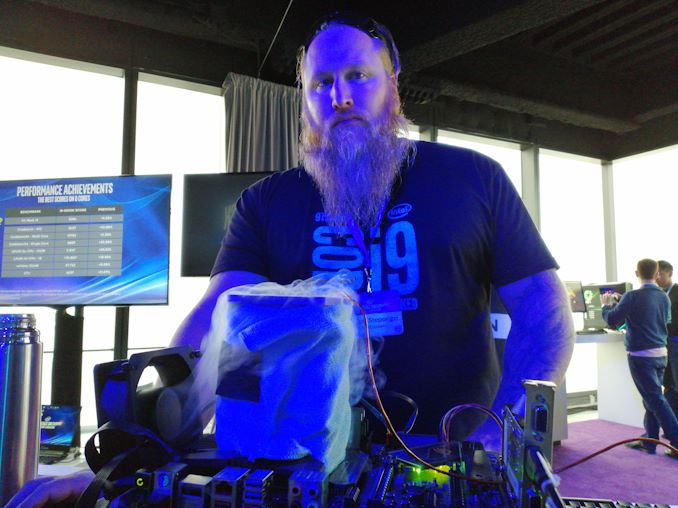
One of the prominent parts of Intel’s announcement this week for the new 9th Generation core processors was that both the overclockable consumer processors and the new high-end desktop processors all feature a soldered thermal interface material (STIM) between the silicon die and the heatspreader. This is a vast improvement over the previous thermal interface material due to the solder's superior ability to conduct thermal energy away from the silicon die. As part of the announcement, Intel also engaged in some extreme overclocking at its launch event using Liquid Nitrogen as an effective coolant, and some overclocking world champions.
Choosing A Thermal Interface Material (TIM)
With the desktop processors we use today, they are built from a silicon die (the smart bit), a package substrate (the green bit), a heatspreader (the silver bit), and a material that helps transfer heat from the silicon die to the heatspreader. The quality of the binding between the silicon die and the heatspreader using this thermal interface material is a key component in the processors ability to remove the heat generated from using it.
Traditionally there are two different types of thermal material: a heat conductive paste, or a bonded metal. Both have positives and negatives.
The heat conductive paste is a universal tool – it can be applied to practically any manufactured processor, and is able to deal with a wide range of changing conditions. Because metals expand under temperature, when a processor is used and gets hot, it expands – so does the heatspreader. The paste can easily deal with this. This allows paste-based processors to live longer and in more environments. Using a bonded metal typically reduces the level of thermal cycling possible, as the metal also expands and contracts in a non-fluid way. This might mean the processors has a rated lifespan of several years, rather than a dozen years. However, the bonded metal solution performs a lot, lot better – metal conducts heat better than the silicon-based pastes – but it is slightly more expensive (a dollar or two per unit, at most, when the materials and manufacturing are taken into account).
| Thermal Interface | |||||||
| Intel | |||||||
| Intel | Celeron | Pentium | Core i3 | Core i5 | Core i7 Core i9 |
HEDT | |
| Sandy Bridge | LGA1155 | Paste | Paste | Paste | Bonded | Bonded | Bonded |
| Ivy Bridge | LGA1155 | Paste | Paste | Paste | Paste | Paste | Bonded |
| Haswell / DK | LGA1150 | Paste | Paste | Paste | Paste | Paste | Bonded |
| Broadwell | LGA1150 | Paste | Paste | Paste | Paste | Paste | Bonded |
| Skylake | LGA1151 | Paste | Paste | Paste | Paste | Paste | Paste |
| Kaby Lake | LGA1151 | Paste | Paste | Paste | Paste | Paste | - |
| Coffee Lake | 1151 v2 | Paste | Paste | Paste | Paste | Paste | - |
| CFL-R | 1151 v2 | ? | ? | ? | K = Bonded | - | |
| AMD | |||||||
| Zambezi | AM3+ | Bonded | Carrizo | AM4 | Bonded | ||
| Vishera | AM3+ | Bonded | Bristol R | AM4 | Bonded | ||
| Llano | FM1 | Paste | Summit R | AM4 | Bonded | ||
| Trinity | FM2 | Paste | Raven R | AM4 | Paste | ||
| Richland | FM2 | Paste | Pinnacle | AM4 | Bonded | ||
| Kaveri | FM2+ | Paste / Bonded* | TR | TR4 | Bonded | ||
| Carrizo | FM2+ | Paste | TR2 | TR4 | Bonded | ||
| Kabini | AM1 | Paste | |||||
| *Some Kaveri Refresh were bonded | |||||||
In our Ryzen APU delidding article, we went through the process of removing the heatspreader and conductive paste from a popular low cost product, and we showed that replacing that paste with a bonded liquid metal improved temperatures, overclocking, and performance in mid-range overclocks. If any company wants to make enthusiasts happy, using a bonded metal is the way to go.
Intel on Enthusiasts
For several years, Intel has always stated that they are there for enthusiasts. In the distant past, as the table above shows, Intel provided processors with a soldered bonded metal interface and was happy to do so. In recent times however, the whole product line was pushed into the heat conductive paste for a number of reasons.

Slide for Intel's 4th Gen, which used paste
As Intel was continually saying that they still cared about enthusiasts, a number of users were concerned that Intel was getting itself confused. Some believed that Intel had ‘enthusiasts’ and ‘overclockers’ in two distinct non-overlapping categories. It is what it is, but now Intel has returned to using applying STIM and wants to court overclockers again.
Pushing Frequencies with Liquid Nitrogen
I should be safe in saying that most AnandTech readers understand that in order to push an overclock, bigger and better cooling is required. This might mean a good air cooler, water cooling, or if you want an exotic daily system, chilled water. The idea here is that as the voltage and frequency is raised, more exotic cooling is required to keep the system from overheating. Beyond chilled water, there are a bunch of enthusiasts that use sub-zero coolants.
Competitive overclocking is an industry to which I am relatively intimate: I have at some point in my existence hit #2 in the world rankings, albeit briefly. The nature of the extreme overclocking scene has changed from very motivated enthusiasts and engineers to vendor backed individuals with thousands of dollars in hardware trying to get the very highest frequency, or break particular benchmark world records. It comes down to experience, preparation, and a good amount of luck to get the best hardware and the best results in the world.
For example, the high-frequency world record on an AMD processor is 8794.33 MHz, using a FX-8350 under liquid nitrogen, whereas the Intel record is 8532.17 MHz on a Celeron 352. Each processor runs differently when you get down to -196C, and some of the older processors were better at pushing the envelope. But while newer processors might not clock as high, the additional cores and raw per-MHz performance help push the benchmarking part of the world records higher.
So while a good air overclock on a high-end gaming processor like the Core i7-8086K is around 5.4 GHz, under liquid nitrogen Intel’s hired guns on the day were pushing 6.9 GHz with the latest 9th generation Core i9-9900K on all cores, and reaching 7.1 GHz internally, with up to 7.4 GHz on a single core. Given that the chip is new, there are usually a good couple of months of learning a new platform and chip binning to push it as high as the previous generation, so we’re likely to see higher over the coming months.
The two overclockers hired by Intel, known in the community as Splave and Steponz, were happily breaking records for 8-core processors left right and center for various CPU focused tests. They also achieved at least one ‘global’ world record, beating every other processor that has ever existed, in PCMark 10.
For a few other tests, Intel achieved some best ever 8-core results.
What’s the point?
Not everyone is going to run liquid nitrogen on their system. Not only is the cooling setup a disaster to maintain 24/7, as well as expensive, the inherent instability in the system at this frequency and the tuning required isn’t practical as it requires constant tweaking. Extreme overclocking is often compared to drag racing – to see who can go the quickest quarter mile. There are several parallels – going for the highest frequency might be just a peak speed contest, while running a complex benchmark is more akin to Formula 1. There are users that have been competitive overclocking for decades, and for a select few, it has become a career that has ended up with motherboards that offer new features that everyone who wants to can use. Sure, it isn’t as useful as taking a family saloon to the shops, but it is fun to watch them go.
Related Reading
- Overclocking The AMD Ryzen APUs: Guide and Results
- The Intel Skylake i7-6700K Overclocking Performance Mini-Test to 4.8 GHz
- AMD Ryzen 5 2400G and Ryzen 3 2200G Integrated Graphics Frequency Scaling
- Delidding The AMD Ryzen 5 2400G APU: How To Guide and Results
- EVGA Roboclocker: A Water Cooling Loop for LIQUID NITROGEN
- GIGABYTE’s Liquid Nitrogen Memory Overclocking Motherboard, Z97X-SOC Force LN2
- Thermal Interface and Extreme Overclocking on the Core i7-8086K (with Alva Jonathan)



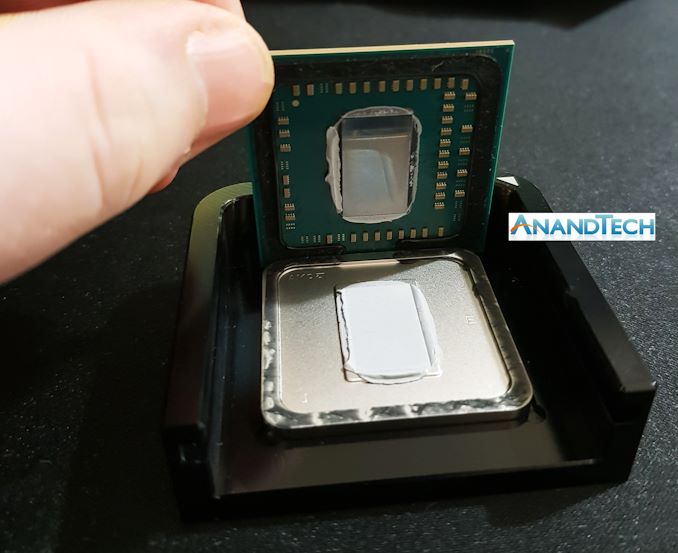
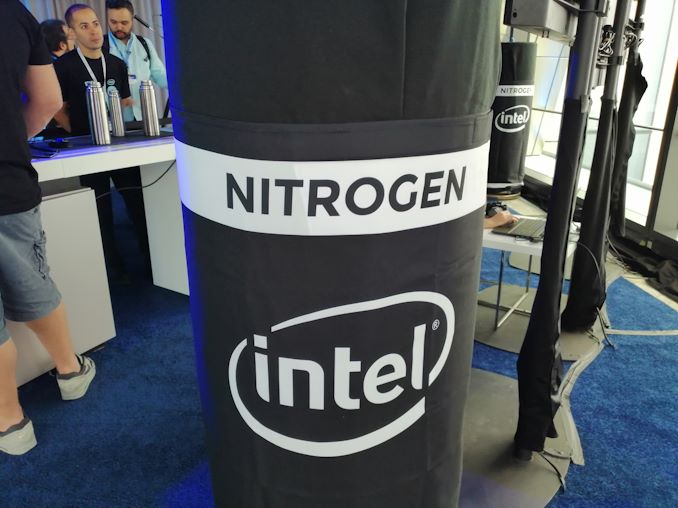
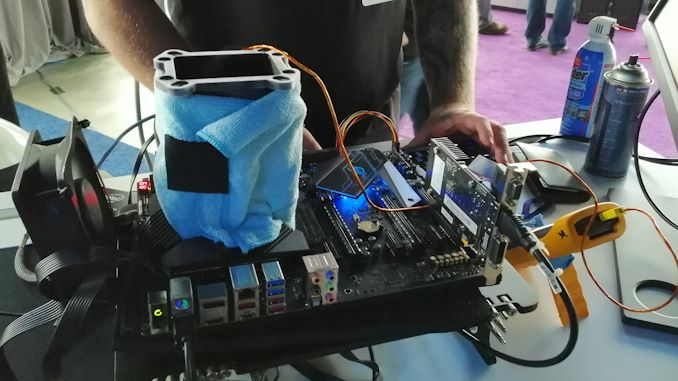
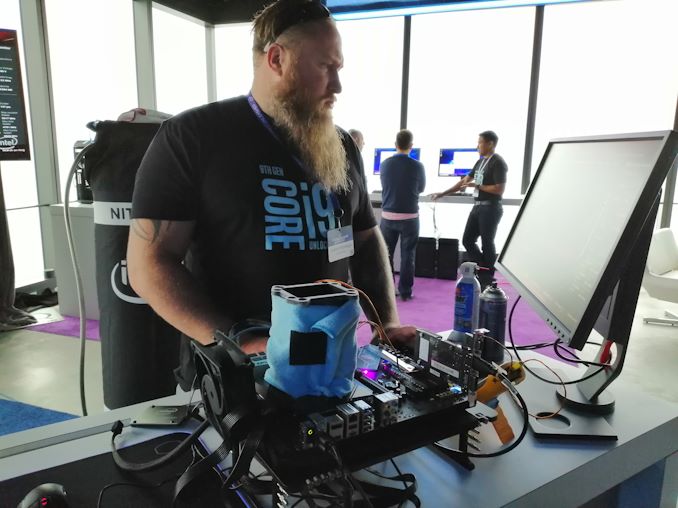
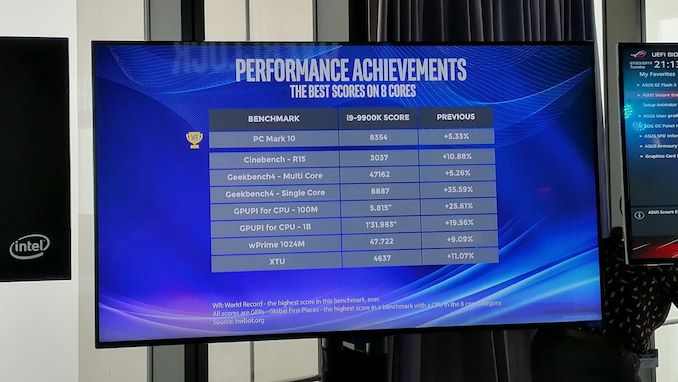








54 Comments
View All Comments
cbm80 - Thursday, October 11, 2018 - link
When there's a gulf between base and turbo clocks, overclocking makes little sense. What does make sense is overTDPing. With a higher TDP you can run turbo most or all the time. Higher performance with no overclocking...Mikewind Dale - Thursday, October 11, 2018 - link
"This might mean the processors has a rated lifespan of several years, rather than a dozen years."That sounds bad. Will we still see some processors with paste? I'd rather buy a more reliable computer with a longer lifespan than a faster computer.
Will multiplier-locked processors still have paste? If the paste is more reliable, and if locked processors have paste, then I'll start buying multiplier-locked processors.
Mr Perfect - Friday, October 12, 2018 - link
I'm curious as to what "several years" means. I've got ye olde Sandy Bridge i7 2600 (non-K mind you) with a soldered heatspreader still going after 7 years. Is it due to keel over shortly? What's the MTBF for soldered CPUS?Oxford Guy - Friday, October 12, 2018 - link
Soldered chips are more reliable than paste TIM chips, not less. This fact applies to the actual enthusiast sector, which is not a pro sector that uses liquid nitrogen.Enthusiasts cool with custom water loops, most typically. Below them are those who use AIO setups. And, believe it or not, some enthusiasts also use air cooling.
Dragonstongue - Thursday, October 11, 2018 - link
PC mark, you know the same company that Intel is "a board member" so they can screw with results in the background to make anything Intel branded show higher numbers then it actually is..They (Intel, and others) should go out of their way to find a "truly" unbiased benchmark suite that is allied and not entrenched with anyone other then the maker themselves to "level the playing field" and so when new CPU-GPU-SSD etc come out and the big corporations want to truly show off they will be able to do so from a "clean slate"
none of this "working behind closed doors" to fleece consumers/customers out of big $$$$$$$$$ expecting one thing and getting a completely other real world result.
Like vehicles that gut the interior, trim down the weight of everything to increase fuel mileage on a closed circuit indoor test track and "claiming" as real expected fuel mileage..its crap way of doing things.
Lord of the Bored - Thursday, October 11, 2018 - link
PCMark isn't a company. Futuremark isn't anymore either, having been purchased and merged into Underwriters Laboratories.PeachNCream - Friday, October 12, 2018 - link
Eh, the importance of a soldered IHS in the consumer space has diminished between Sandy Bridge's release and today. Sure the new CPUs will likely deliver higher overclocks, but the world of 2018 has seen increased outright replacement of desktop PCs with phones, tablets, and laptops. I'm thinking this is more a marketing department checkbox intended to have a halo effect on sales of higher volume non-K processors rather than a serious nod to the diminished number of remaining people that still play games with big, clunky desktop computers.Oxford Guy - Friday, October 12, 2018 - link
"That sounds bad. Will we still see some processors with paste? I'd rather buy a more reliable computer with a longer lifespan than a faster computer."It's typically smoke and mirrors to make Intel's force-feeding of substandard TIM onto enthusiasts all these years. The propaganda has always been about microcracking. The original claim, which was ludicrous but pushed heavily in places like the Anandtech forum, was that microcracking is a problem for soldered chips under air and water. In reality, it's a problem for liquid nitrogen. A PDF that was supposed to seem like credible science kept being posted to prop up this ruse. A big part of the nonsense was the claim that process nodes have shrunk since Sandy so much that the dies are simply too small to support solder. Yes, folks, that nonsense was treated like fact, again and again, in the forums and elsewhere.
AMD has exposed these lies with Ryzen so Intel has had no choice but to abandon its craven thermal paste strategy, a strategy it adopted as a consequence of Bulldozer/Piledriver not competing with Sandy/Ivy. So, Intel apologists are moving the goal posts for the word enthusiast. Now, it's not the typical water loop person. No. It's not liquid nitrogen cooling! Enthusiasts don't use liquid nitrogen. Pros use it. But, since we want to forget about Intel's marketing strategies, like telling actual enthusiasts that it was using better-quality TIM for Devil's Canyon (later exposed to be the same TIM as before), we will pretend that the enthusiast space is about liquid nitrogen.
Intel benefitted from selling its substandard TIM for enthusiast-grade parts. It saved money on the thermal interface. It made money from damaged chips, due to extra sales to replace them. It got marketing from all the delidding traffic. But, now that it has competition it has to offer a better-quality product. This is what competition is about, folks. Monopolies always offer less product quality. You get less for your money when there is monopoly.
For the real enthusiast space, soldered chips should be more reliable, not less. Heat is the enemy, not microcracks, unless you're a pro using truly exotic impractical cooling which is what liquid nitrogen is.
Oxford Guy - Friday, October 12, 2018 - link
Add "look better" to the end of my first sentence.PeachNCream - Monday, October 15, 2018 - link
"Enthusiasts don't use liquid nitrogen. Pros use it."Hubawah? What professional uses liquid nitrogen to cool a processor? In a professional environment, computers are typically OEM builds from a relatively well known brand. There's nothing professional about extreme overclocking except that sometimes a hardware manufacturer that might have a professional workforce sponsors a team or an event in order to help get their name out through side-channel marketing.